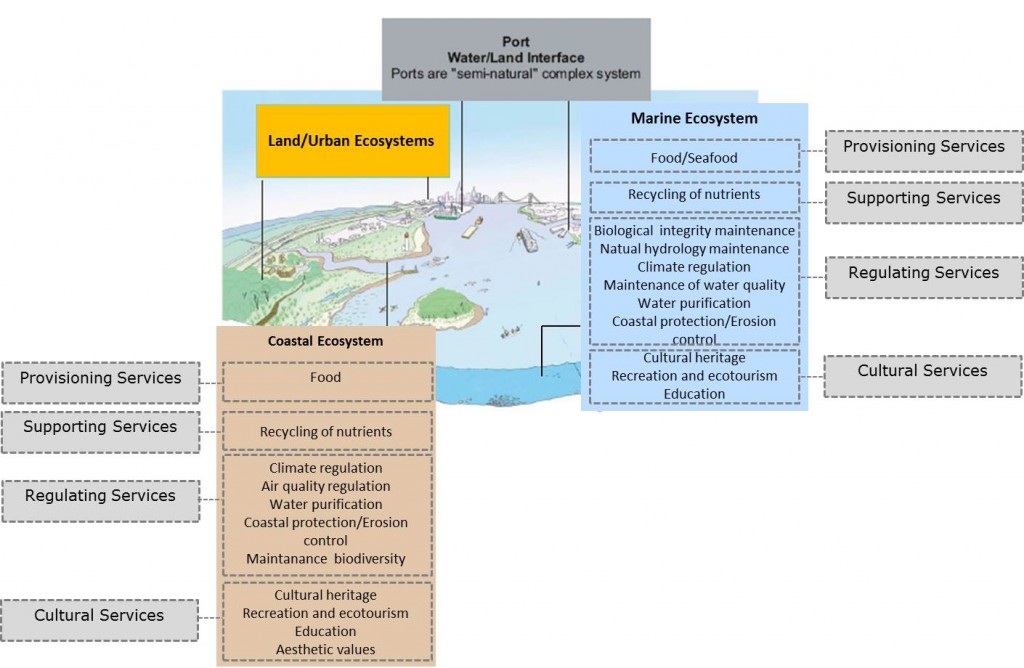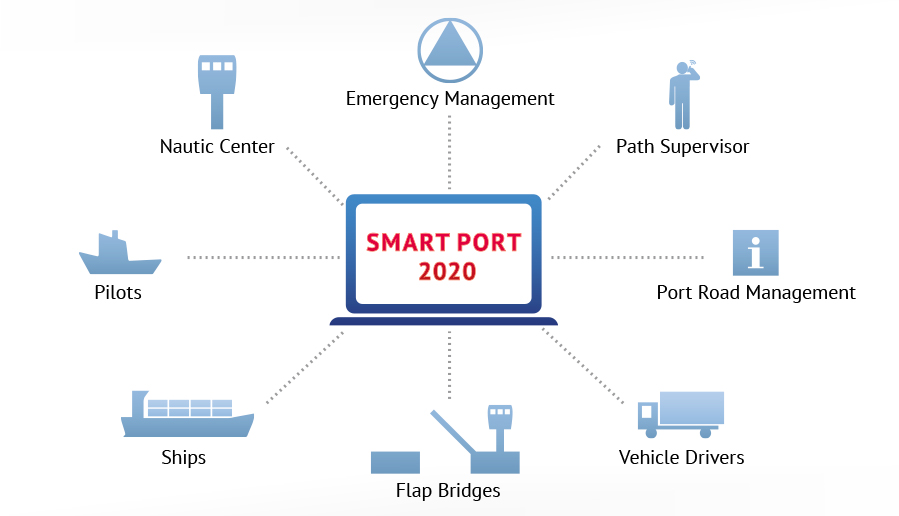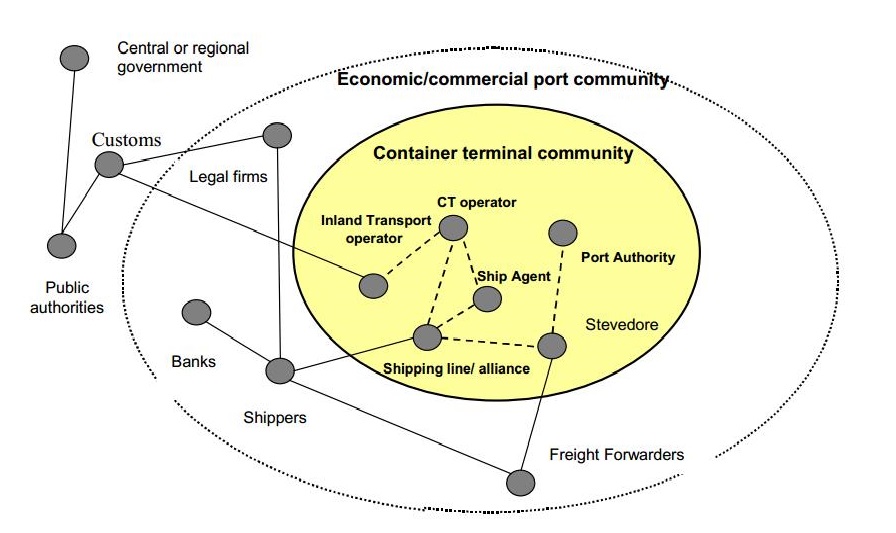European strategies [3] aim to a smart and sustainable growth also in transport planning. Main objectives to be achieved by 2050 are the reduction of 60% [4] of the transport emissions and 40% of the maritime transport.
The challenges already in place in ports, to ensure sustainable development and competitiveness, are:
-
Increasing the volume of traffic (passengers/freight)
-
Reducing congestion/improve accessibility
-
Mitigating impacts
-
Using Alternative Energy
-
Encouraging the ecosystem approach to the management/territorial planning of resources
Therefore, Ecosystem Services, Sustainable Energy Action Plan, Smart City, Community Involvement, Accessibility are some essential key concepts in order to discuss about “sustainable port system management”.
Ecosystem Services
The components, processes and functions of ecosystems [5] are the Ecosystems Services (ES). They have a “public” value, because they provide irreplaceable benefits [6], direct or indirect, for the inhabitants of a territory. The conversion from natural Ecosystems to semi-natural or artificial systems is a major cause of loss of biodiversity and ES. According to EU policies [7], many cities are experiencing an ecosystem approach in the port systems, in order to conciliate promotion of economic growth and environmental conservation. Recently, the debate on the ES has involved different disciplines, in particular about how to evaluate and integrate them into the planning process [8]. Today is a good time to deal with the ES in urban port areas, essentially for two reasons: in many cases some spaces for commercial port activities were left empty due to the evolution of port logistics; there is an increasing tendency to reconstitute within urbanized areas ecologically important spaces. The port areas are opportunities for redevelopment, rehabilitation, integration and unmissable chances to restore/insert some Ecosystems and their services [9].
The Ecosystem Services in port areas. (Adapted from Coastal Ecosystems, Port Authority of New York & New Jersey, www.panynj.gov)
Sustainable Energy Action Plan – SEAP
The SEAP is a long-term programmatic document [10], that translates strategies and goals into concrete actions in order to combat climate change [11]. In the port areas, it provides measures aimed to reduce the environmental impact, the energy consumption resulting from the ports, maritime transport and volumes traffic to/from the port area. It is based on strategies to mitigate greenhouse gas (development of sustainable mobility with reduced/zero emissions; freight/passenger distribution optimization; cold ironing, automation of port services, use of biofuels/renewable energy sources) and adaptation strategies to limit global warming (construction/rehabilitation of green and blue infrastructures, waterways, green areas, waterfront, etc..).
Smart City
A Smart City is an urban environment that can actively work to improve the quality of life of its citizens, through sustainable economic development, based on research, innovation, technology and integrated planning. In the port systems, affected by significant traffic flows to/from the port area, especially when it is near the city center, the problems of congestion and pressure on the mobility system are amplified. To become a Smart Port, the use of information and communication technologies, ICT, is essential to increase, thought the info-mobility and logistics projects, energy efficiency, accessibility and intermodality, in order to optimize the goods/passengers flows.
Genova Smart City. (© Metroweb Genova [12], 2014)
Community Involvement
A trend already in place in EU policies [13] is to promote the Community Involvement (CI) [14] in decisions making, a process of stakeholders identifying and involvement of their relevant interests/needs/principles. Especially in the port planning, which is characterized by strong environmental, social and economic impacts, it is important to involve all the stakeholders from the beginning of the planning process, with different levels of involvement during the planning phases. The CI ensures maximum transparency in decisions making and, through the contributions of stakeholders, the sharing of final decisions.
The container terminal community and its stakeholders. (Henesey L.E., Notteboom T.E., Davidsson P., 2003, “Agent-based simulation of stakeholders relations: An approach to sustainable port and terminal management”, Proceeding of International Association of Maritime Economists Annual Conference, Busan, Korea, 2003).
Accessibility
The traditional transport planning aims to encourage mobility, meant capacity to perform the movements as quickly as possible, mostly by private means, not considering, in a suitable way, the resulting impacts. EU policies [15] promote, instead, sustainable mobility [16], to improve the accessibility, the potential interaction between various human activities across the country. Planning for accessibility involves high energy efficiency, social equity [17] and reduction of negative generated externalities. People/goods accessibility is an essential key component for port development, to reconcile operating performance, economic competitiveness and environmental management.
Notes
[1]Including projects MED programme PORTA- PORTs as a gateway for Access inner regions, www.porta-project.eu; INTERREG IVC programme GRaBS- Green and Blue Space Adaptation for Urban Areas and Eco Towns, www.grabs-eu.org; Intelligent Energy Europe programme SPECIAL- Special Planning and Energy for Communities In All Landscapes, www.special-eu.org
[2] Includind “RegioResourcesR 21-A cross-disciplinary dialogue on sustainable development of regional resources”, 18-20 September 2013, University of Catania, Italy, https://regioresources21.eli-web.com/
[3] European Commission (2001), White Paper European transport policy for 2010: time to decide; European Commission (2011), White Paper Roadmap to a Single European Transport Area – Towards a competitive and resource efficient transport system; Europe 2020 Strategy
[4]% compared to 1990 levels
[5] “A dynamic complex of plant, animal, and microorganism communities and the nonliving environment, interacting as a functional unit” (Millennium Ecosystem Assessment, 2003)
[6] The benefits are grouped by the Millennium Ecosystem Assessment in 4 categories: provisioning, regulating, supporting and cultural
[7] European Commission (2008), Integrated ecosystem approach to resources management, knowledge to develop coastal and marine spatial planning options to help optimize the management of marine and maritime activities and their sustainable development
[8] For more details refer to: Ignaccolo M., Inturri G., Cocuzza E. (2013), Ecosystem services, basis for a process of shared planning of port sustainable areas, RegioResourcesR 21-A cross-disciplinary dialogue on sustainable development of regional resources, 18-20 September 2013, University of Catania, Italy
[9] Some examples are the conversion of London’s Docklands, the creation of Core Natural Areas in the port of Antwerp, the redevelopment of Hammarby Sjostad in Stockholm
[10]Provided for the Covenant of Mayors, www.covenantofmayors.eu; it is the key document for countries, cities and regions to reducing their emissions beyond the target of 20%
[11] Europe 2020 Strategy aims to reduce its greenhouse emissions by at least 20% compared to 1990 levels, or by 30% if the conditions are right, increase its energy efficiency by 20% and raise the share of renewable energies in overall energy consumption to 20%
[12]For more details about Genova Smart City refer to: www.genovasmartcity.it. About Metroweb Genova S.P.A., project partner: www.genova.metroweb.it
[13]Aarhus Convention of 1998, Directive 2003/35/EC, Directive 2001/42/EC, Agenda 21
[14] For more details refer to: Ignaccolo M., Le Pira M., Inturri G. (2013), “The role of Public Participation in sustainable port planning”, Portus, no. 26
[15] European Commission (2007), Green Paper Towards a new culture for urban mobility
[16] Mobility suitable to satisfy the moving needs of the modern generations without compromyzing the possibility of the next generations to satisfy their own moving needs
[17]Possibility for all social categories to move using different transport modalities
References
- [ES] Millennium Ecosystem Assessment (2003), Ecosystems and Human Well-being. A Framework for Assessment, www.maweb.org.
- [SEAP] European Commission (2010), How to develop a Sustainable Energy Action Plan (SEAP) – Guidebook.
- [Smart City] European Commission (2012), FIREBALL White Paper Smart Cities as Innovation Ecosystems Sustained by the Future Internet, www.fireball4smartcities.eu.
- [Community Involvement] Cascetta E., Pagliara F. (2013), “Public engagement for planning and designing transportation Systems”, Procedia – Social and Behavioral Sciences, vol. 87, pp. 103-116.
- [Accessibility] Banister D. (2008), “The sustainable mobility paradigm”, Transport Policy, vol.15, iss. 2, pp. 73-80.
Head Image: Loading and unloading of container in the Port of Rotterdam.
Verso una portualità sostenibile
Le strategie Europee [3] mirano alla crescita intelligente e sostenibile anche nella pianificazione dei trasporti. Principali obiettivi da perseguire entro il 2050 sono la riduzione del 60% [4] delle emissioni prodotte dai trasporti e del 40% da quelli marittimi.
Le sfide già in atto nei porti, al fine di garantire sviluppo sostenibile e competitività, sono:
- Aumentare i volumi di traffico (persone/merci)
- Ridurre la congestione/migliorare l’accessibilità
- Mitigare gli impatti
- Utilizzare energie alternative
- Incentivare l’approccio ecosistemico nella gestione/pianificazione territoriale delle risorse
Pertanto, Servizi Ecosistemici, Piano di Azione per l’Energia Sostenibile, Smart City, Coinvolgimento della comunità, Accessibilità sono chiavi di lettura imprescindibili per trattare di “portualità sostenibile”.
Servizi Ecosistemici
I componenti, i processi e le funzioni degli ecosistemi [5] sono i Servizi Ecosistemici (SE). Hanno un valore “pubblico”, perché forniscono agli abitanti di un territorio benefici [6] insostituibili, diretti o indiretti. La conversione di Ecosistemi naturali in sistemi semi-naturali o artificiali è tra le principali cause di perdita di biodiversità e di SE. In linea con le politiche dell’UE [7], molte città stanno sperimentando un approccio ecosistemico in ambito portuale, conciliando promozione della crescita economica e conservazione dell’ambiente. Recentemente il dibattito sui SE ha coinvolto diverse discipline, in particolare su come valutarli e integrarli nei processi di pianificazione [8]. Oggi è un buon momento per affrontare tale tema nei porti urbani essenzialmente per due motivi: in molti casi, alcuni spazi per le attività portuali commerciali sono stati lasciati vuoti, a causa dell’evoluzione della logistica portuale; inoltre, c’è una crescente tendenza a ricostituire all’interno delle aree urbanizzate spazi ecologicamente importanti. Le aree portuali sono occasioni di riqualificazione, recupero, integrazione e imperdibili opportunità per ripristinare/inserire [9] alcuni Ecosistemi e i loro Servizi.
I Servizi Ecosistemici in ambito portuale. (Adattato da Coastal Ecosystems, Port Authority of New York & New Jersey, www.panynj.gov)
PAES – Piano di Azione per l’Energia Sostenibile
Il PAES è un documento programmatico [10] di lungo periodo, che traduce strategie e obiettivi in azioni concrete per la lotta al cambiamento climatico [11]. In ambito portuale, prevede interventi finalizzati alla riduzione degli impatti ambientali, dei consumi energetici derivanti dai porti, trasporti marittimi e volumi di traffico da/verso l’area portuale. È improntato su strategie di mitigazione dei gas effetto serra (sviluppo mobilità sostenibile a emissioni ridotte/nulle; ottimizzazione distribuzione merci/passeggeri; cold ironing; automazione dei servizi portuali; impiego di biocarburanti/fonti di energia rinnovabili) e su strategie di adattamento per limitare il riscaldamento globale (realizzazione/ripristino di infrastrutture verdi e azzurre, corsi d’acqua, green areas, waterfront, ecc.).
Smart City
Una Smart City è, nel senso più ampio, un ambiente urbano che può lavorare attivamente per migliorare la qualità della vita dei suoi cittadini, attraverso uno sviluppo economico sostenibile, basato su ricerca, innovazione, tecnologia e una logica di pianificazione integrata. Nei sistemi portuali, interessati da notevoli flussi di traffico da e verso l’area portuale, specialmente se vicina al centro urbano, le problematiche di congestione e pressione sul sistema della mobilità sono amplificate. Per diventare Smart Port, l’uso di Tecnologie dell’Informazione e della Comunicazione, TIC, è fondamentale al fine di incrementare, grazie a progetti di infomobilità e logistica, sia l’efficienza energetica che l’accessibilità e intermodalità in grado di ottimizzare i flussi di merci/passeggeri.
Genova Smart City. (© Metroweb Genova [12], 2014)
Community Involvement
Una tendenza già in atto nelle politiche UE [13] è favorire il coinvolgimento delle Comunità [14] nei processi decisionali, ovvero un processo di identificazione di gruppi di stakeholder e coinvolgimento dei relativi interessi/necessità/principi. Specialmente nella pianificazione dei sistemi portuali, caratterizzati da forti impatti ambientali, sociali ed economici, è importante coinvolgere le parti interessate fin dall’inizio del processo di pianificazione, con diversi livelli di coinvolgimento nelle differenti fasi, al fine di ottenere un processo decisionale trasparente, arricchito dai contributi delle categorie interessate in modo tale che supportino decisioni finali condivise.
Gruppi di stakeholder in una “Terminal Container Community. (Henesey L.E., Notteboom T.E., Davidsson P., 2003, “Agent-based simulation of stakeholders relations: An approach to sustainable port and terminal management”, Proceeding of International Association of Maritime Economists Annual Conference, Busan, Korea, 2003).
Accessibilità
La pianificazione dei trasporti tradizionale è orientata a favorire la mobilità, intesa come potenzialità di compiere spostamenti il più rapidamente possibile, per lo più con il mezzo privato, non considerando adeguatamente i conseguenti impatti. Le politiche EU [15] promuovono, invece, la Mobilità Sostenibile [16], improntata sul miglioramento dell’accessibilità, intesa come potenzialità di interazione tra diverse attività umane distribuite sul territorio. Pianificare per l’accessibilità implica elevata efficienza energetica, equità sociale [17] e riduzione delle esternalità negative generate. L’accessibilità per persone/merci è una componente fondamentale per lo sviluppo portuale, determinante per conciliare performance operativa, competitività economica e gestione ambientale.
Note
[1] Tra cui i progetti MED programme PORTA- PORTs as a gateway for Access inner regions, www.porta-project.eu; INTERREG IVC programme GRaBS- Green and Blue Space Adaptation for Urban Areas and Eco Towns, www.grabs-eu.org; Intelligent Energy Europe programme SPECIAL- Special Planning and Energy for Communities In All Landscapes, www.special-eu.org
[2] Tra cui “RegioResourcesR 21-A cross-disciplinary dialogue on sustainable development of regional resources”, 18-20 September 2013, University of Catania, Italy, https://regioresources21.eli-web.com/
[3] Commissione Europea (2001), Libro bianco La politica europea dei trasporti fino al 2010: il momento delle scelte; Commissione Europea (2011), il Libro bianco Tabella di marcia verso uno spazio unico europeo dei trasporti – Per una politica dei trasporti competitiva e sostenibile; Il Pacchetto europeo Clima energia
[4] % rispetto ai livelli del 1990
[5] “Complesso dinamico di comunità vegetali, animali, microbiche e componenti abiotiche che interagiscono come un’unità funzionale” (Millennium Ecosystem Assessment, 2003)
[6] I benefici sono raggruppati dal Millennium Ecosystem Assessment in 4 categorie: provisioning, regulating, supporting and cultural
[7] Commissione Europea (2008), Integrated ecosystem approach to resources management, knowledge to develop coastal and marine spatial planning options to help optimize the management of marine and maritime activities and their sustainable development
[8] Per maggiori dettagli si rimanda a: Ignaccolo M., Inturri G., Cocuzza E. (2013), Ecosystem services, basis for a process of shared planning of port sustainable areas, RegioResourcesR 21-A cross-disciplinary dialogue on sustainable development of regional resources, 18-20 September 2013, University of Catania, Italy
[9] Esempi sono la riconversione dei Docks di Londra, la creazione di Core Natural Areas nel porto di Anversa; la riqualificazione di Hammarby Sjostad a Stoccolma
[10] Previsto dal Patto dei Sindaci, www.pattodeisindaci.eu, è un’iniziativa per cui paesi, città e regioni si impegnano volontariamente a ridurre le proprie emissioni di CO2 oltre l’obiettivo del 20%
[11] Il Pacchetto europeo Clima energia, entrato in vigore nel giugno 2009, efficace dal gennaio 2013 fino al 2020, prevede entro il 2020 di tagliare le emissioni di gas serra del 20%, ridurre il consumo di energia del 20%; incrementare l’uso delle energie rinnovabili, portando al 20% il consumo totale europeo generato da fonti rinnovabili
[12] Per info su Genova Smart City: www.genovasmartcity.it. Su Metroweb Genova S.P.A., socio del progetto: www.genova.metroweb.it
[13]Convenzione di Aarhus del 1998, direttiva 2003/35/CE, direttiva 2001/42/CE, Agenda 21
[14] Per maggiori dettagli si rimanda a: Ignaccolo M., Le Pira M., Inturri G. (2013), “The role of Public Participation in sustainable port planning”, PORTUS, no. 26
[15] Commissione Europea (2007), Libro verde Verso una nuova cultura della mobilità urbana
[16] Mobilità in grado di soddisfare i bisogni di spostamento delle generazioni attuali senza compromettere la possibilità che le generazioni future soddisfino i loro bisogni di spostamento
[17] Possibilità per tutte le categorie sociali di muoversi utilizzando diverse modalità di trasporto
Bibliografia
- [ES] Millennium Ecosystem Assessment (2003), Ecosystems and Human Well-being. A Framework for Assessment, www.maweb.org.
- [SEAP] European Commission (2010), How to develop a Sustainable Energy Action Plan (SEAP) – Guidebook.
- [Smart City] European Commission (2012), FIREBALL White Paper Smart Cities as Innovation Ecosystems Sustained by the Future Internet, www.fireball4smartcities.eu.
- [Community Involvement] Cascetta E., Pagliara F. (2013), “Public engagement for planning and designing transportation Systems”, Procedia – Social and Behavioral Sciences, vol. 87, pp. 103-116.
- [Accessibility] Banister D. (2008), “The sustainable mobility paradigm”, Transport Policy, vol. 15, iss. 2, pp. 73-80.
Head image: Operazioni di scarico e scarico dei container nel Porto di Rotterdam.


